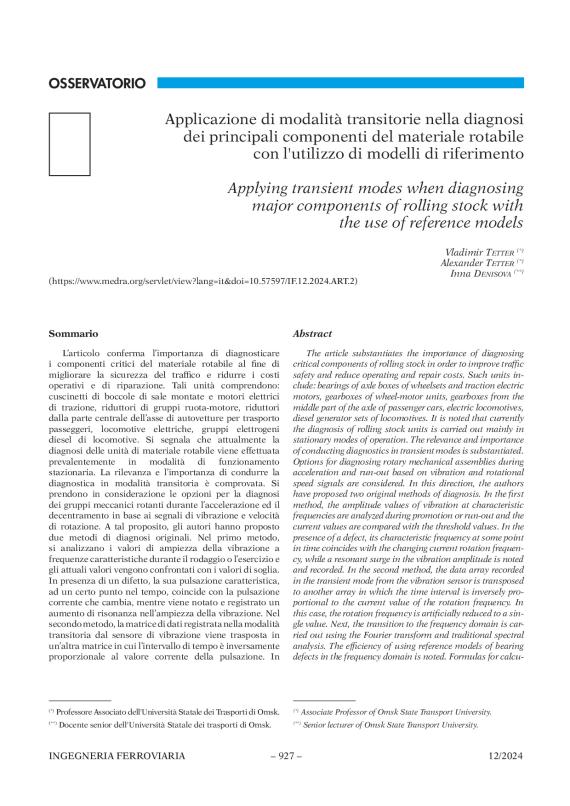
Abstract - The article substantiates the importance of diagnosing critical components of rolling stock in order to improve traffic safety and reduce operating and repair costs. Such units include: bearings of axle boxes of wheelsets and traction electric motors, gearboxes of wheel-motor units, gearboxes from the
middle part of the axle of passenger cars, electric locomotives, diesel generator sets of locomotives. It is noted that currently the diagnosis of rolling stock units is carried out mainly in stationary modes of operation. The relevance and importance of conducting diagnostics in transient modes is substantiated.
Options for diagnosing rotary mechanical assemblies during acceleration and run-out based on vibration and rotational speed signals are considered. In this direction, the authors have proposed two original methods of diagnosis. In the first method, the amplitude values of vibration at characteristic frequencies are analyzed during promotion or run-out and the current values are compared with the threshold values. In the presence of a defect, its characteristic frequency at some point in time coincides with the changing current rotation frequency, while a resonant surge in the vibration amplitude is noted and recorded. In the second method, the data array recorded in the transient mode from the vibration sensor is transposed to another array in which the time interval is inversely proportional to the current value of the rotation frequency. In this case, the rotation frequency is artificially reduced to a single value. Next, the transition to the frequency domain is carried out using the Fourier transform and traditional spectral analysis. The efficiency of using reference models of bearing defects in the frequency domain is noted. Formulas for calculating the characteristic frequencies of individual rolling bearing elements are given. An example of diagnosing gearboxes using dynamic reference temperature models is considered. It is noted as a promising method for tracking the dynamics of changes in temperature fields to determine the technical condition of axle boxes during bench tests of wheelsets. It has been established that diesel generator sets of diesel locomotives operate for a considerable time (up to 50%) in transient modes, during which malfunctions are most likely to occur. There is a lack of research in this area and a lack of practical implementations. The results of the authors’ research work on diesel locomotives of several series on the analysis of the work in the dynamics of the gas-air tract, the cylinder-piston group of diesel and fuel equipment elements are presented. In conclusion, the advantages and prospects of the considered approaches in the diagnosis of critical components of rolling stock are presented.
https://www.medra.org/servlet/view?lang=it&doi=10.57597/IF.12.2024.ART.2
- Dicembre


